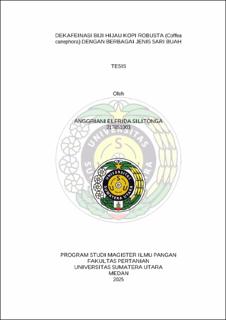Dekafeinasi Biji Hijau Kopi Robusta (Coffea canephora) dengan Berbagai Jenis Sari Buah
Decaffeination of Robusta Green Coffee Beans (Coffea canephora) with Various Types of Fruit Juice

Date
2025Author
Silitonga, Anggriani Elfrida
Advisor(s)
Sinaga, Hotnida
Silalahi, Jansen
Metadata
Show full item recordAbstract
The most widely grown types of coffee in Indonesia are Arabica and Robusta, and Robusta coffee has a higher caffeine content than Arabica coffee. Caffeine is the main compound found in coffee and plays a role in improving psychomotor performance and providing physiological effects on the body, namely increasing energy. However, some consumers are sensitive to caffeine, which can cause insomnia and digestive problems. The purpose of this study was to reduce the caffeine content of coffee enzymatically using protease enzymes because protein degradation in the coffee bean membrane can reduce caffeine content. This enzyme was obtained from pineapple juice, papaya juice, chayote juice and ginger juice and determined the best soaking time. In the first step, the optimal concentration of juice was determined, which resulted in the most effective reduction in caffeine levels from the types of juices that had two treatment factors. Factor 1 is the type of juice with 4 treatment levels (pineapple juice, papaya juice, chayote juice, and ginger juice) and factor 2 is the percentage of juice with 5 treatment levels (10%, 20%, 30%, 40% and 50%). The optimal concentration is based on the reduction in caffeine levels, namely 40% pineapple juice, 50% papaya juice, 50% chayote juice, and 40% ginger juice. Then decaffeination was carried out with variations in soaking time, with two treatment factors. Factor 1 is the best type of juice which includes 4 levels of treatment (40% pineapple juice, 50% papaya juice, 50% chayote juice and 40% ginger juice) and factor 2 is the soaking time with 3 levels of treatment (12 hours, 24 hours and 36 hours). Each treatment produced lower caffeine levels compared to the control. Before the fermentation process, the caffeine content was 2.134% in the raw material, but after the enzymatic process there was a significant decrease, starting from 1.295% in chayote juice to 1.411% in pineapple juice. The higher the concentration of the juice used, the lower the caffeine content of the coffee beans. The results showed that the longer the soaking time affected the decrease in caffeine content, protein content, and fat content but increased the water content and taste value of the coffee beans. The decrease in caffeine content was caused by the breakdown of caffeine by the activity of the protease enzyme from the use of fruit juice.
Collections
- Master Theses [51]
